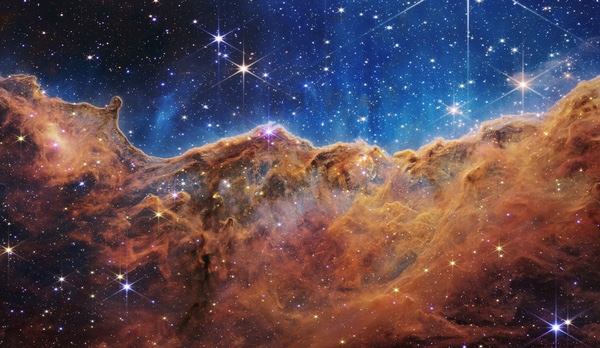The transformation of JWSTby Jeff Foust
|
| “I didn’t know I was going to be at a pep rally,” Nelson said. “It’s all the better. You’ve got a lot to be rallying for.” |
Yet the atmosphere inside an auditorium last Tuesday at NASA’s Goddard Space Flight Center resembled that of a high school field house ahead of a big Friday night football game. A standing room audience, ranging from NASA leadership and members of Congress to scientists and engineers that worked on JWST, packed the room, while an emcee worked the crowd. “Let’s get excited!” she said, and the crowd cheered loudly.
Not loudly enough. “You can do a little better than that. Let me hear you again!” she implored. The crowd cheered about as loud as it did before. Good enough, apparently.
Then there were the ersatz cheerleaders, wielding gold pom-poms and gold cardboard hexagons, resembling the mirror segments of the space telescope. They first lined the stairwell leading up to the auditorium, yelling so loudly at times that some inside the room wondered if something either fantastic or disastrous had happened. They later took the stage.
“Gimme a J!” they shouted, and the audience complied. “Gimme a W! Gimme an S! Gimme a T! What’s that spell?” Um, JWST?
The atmosphere even took some NASA officials by surprise. “I didn’t know I was going to be at a pep rally,” NASA administrator Bill Nelson said when he took the stage. “It’s all the better. You’ve got a lot to be rallying for.”
“When I came up the stairs, by the time I got to the top, I wanted to throw off my jacket and run out to the 50-yard line,” quipped Greg Robinson, the program director for JWST at NASA headquarters who, decades earlier, played college football. “I don’t know what I would have done when I got there.”
That trying-too-hard overenthusiasm extended to the actual image release event, which took place not in that Goddard auditorium but in studios at the center and other locations in Europe and Canada. The unveiling of the four images and one spectrum was spread out over one hour, with lots of filler in the form of background information, interviews, and so on. But the event was riddled with technical glitches as the producers tried to jump from one studio to the next or bring up feeds of watch parties from Italy to India. When the show tried to turn to Canadian Space Agency headquarters to unveil an exoplanet spectrum, a buffering YouTube stream appeared on the screen, to groans and nervous laughter from the audience in the Goddard auditorium.
All could be forgiven, if not completely forgotten, by the time the images finally appeared. The images of the Carina Nebula, Southern Ring Nebula, a cluster of galaxies known as Stephan’s Quintet, and a deep field around the galaxy cluster SMACS 0723, and a spectrum of the exoplanet WASP-96 b, were hailed by professional astronomers and the general public alike.
“For me, the first thing that stood out about that image,” Amber Straughn, JWST deputy project scientist for communications at NASA Goddard, said of the deep field image, “was just the astounding detail that you can see in some of these galaxies. You can see star-forming regions in what are almost certainly very distant galaxies. They just pop out.”
| “We’re making discoveries and we’ve really haven’t started trying yet. The promise of this telescope is amazing,” said Smith. |
Even scientists who have been involved with JWST for decades were surprised. “I’ve been working on this project for 20 years, so we should expect what we saw,” said René Doyon of the University of Montreal, principal investigator for JWST’s Near-Infrared Imager and Slitless Spectrograph instrument. “But no. Several times in the last six months I nearly broke my jaw from what I saw, these incredible images.”
“I think our fellow scientists will feel the same thing when they look at the data,” he added. “These data are just amazing.”
That enthusiasm spread to the White House as well. That deep field image was unveiled the day before at an event attended by President Joe Biden and Vice President Kamala Harris. The oddly staged event—the president, vice president, and others sitting at desks, with a giant screen in the background—started more than an hour later, and the public portion ended after only about ten minutes, with only brief comments from Biden, Harris, and Nelson.
However, the briefing continued behind closed doors. “It was really fun. Oh my gosh,” recalled Jane Rigby, JWST operations project scientist at Goddard, who was there to explain the images. “They really geeked out. We had a closed-door session where we walked through all the images and just shared the excitement. They were so thrilled.”
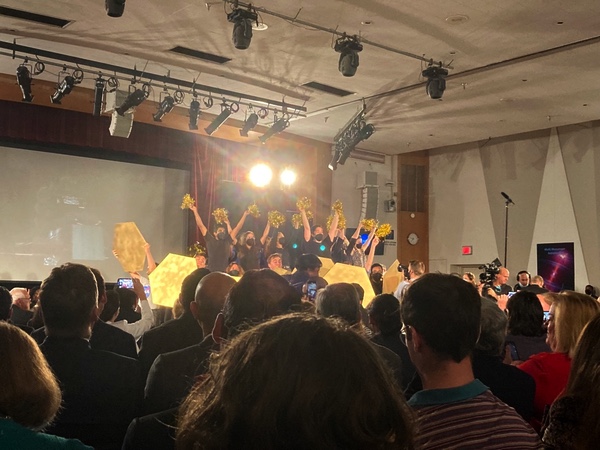 The celebration of the first JWST images at the Goddard Space Flight Center resembled a pep rally, including cheerleaders. (credit: J. Foust) |
“The promise of this telescope is amazing”
The purpose of JWST is not to produce images that excite the president and the public, but to perform cutting-edge science. The early release observations released last week offered a little bit of science: the spectrum of WASP-96 b, for example, revealed the presence of water vapor in that “hot Jupiter” exoplanet that orbits close to its star, while the deep field image revealed a galaxy more than 13 billion years old, and thus dating back to less than a billion years after the Big Bang.
The observations, though, were more about demonstrating the scientific potential of JWST. “They were more or less practice runs with the instruments,” said Eric Smith, JWST program scientist at NASA headquarters, at a briefing after the main event. “We’re making discoveries and we’ve really haven’t started trying yet. The promise of this telescope is amazing.”
Rigby recalled getting emotional when she saw some of the commissioning data, including “razor sharp” images better than expected. “Oh my goodness, it works, and it works better than we thought,” she said. “Personally, I went and had an ugly cry, because what the engineers have done to build this thing, it is amazing.”
It may take some time to truly push the limits of JWST, scientists suggested. The telescope is now starting a program of observations called Cycle 1 based on proposals submitted by scientists long before the telescope launched, and thus based on estimates and predictions. “Everything we planned for Cycle 1 in the astronomical community was bold, but it wasn’t bold enough,” Smith said.
He later explained at the briefing that astronomers submitting their Cycle 1 proposals were likely conservative in the number of objects they could observe or exposure times. “Now, what they’ll see when they can have access to these data is that they can expose shorter in some cases. They can have more targets, or they can go deeper than they thought. By Cycle 2—the next round of observations, proposals for which will be requested later this year—he said he expected astronomers “will be much more adventurous because they now know just how good the facility is.”
Even then, it will take years to analyze data and make the breakthrough discoveries, from the solar system to the early universe, long promised by the telescope. “We’ve designed this telescope and instrument to do incredible science that we’re going to start executing now, but we really don’t know what we’re going to find,” said Doyon.
He cited the example of the Hubble Space Telescope, launched with a major science goal of measuring the Hubble Constant, a measure of the rate of the expansion of the universe, only to discover that the expansion of the universe is accelerating. “Who knows what’s coming for JWST, but I’m sure we’re going to have a lot of suprises.”
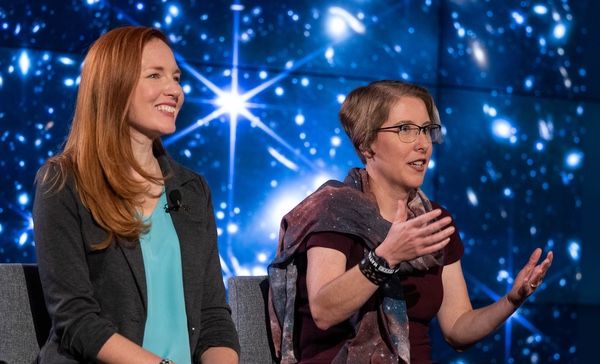 Astronomers Amber Straughn (left) and Jane Rigby discuss the early release observations at a July 12 briefing. (credit: NASA/Bill Ingalls) |
Beating spec
The reason scientists could be so exuberant and so hopeful about JWST is because the telescope worked better than expected. At the time of its launch last December, NASA warned of hundreds of potential single-point failures during the deployment and commissioning of the telescope and its instruments, failures that could impair or imperil the mission.
| “We knew how significant this observatory is. It’s the biggest, most complex science mission, potentially, that NASA has ever built,” Feninberg said. |
Yet the telescope made it through the six-month commissioning process with flying colors. “I was interviewed on ‘60 Minutes’ and when I got asked about confidence, I said I was 100% confident,” recalled Bill Ochs, JWST project manager at Goddard, during a briefing in June at the Space Telescope Science Institute. “Now, if you would have asked me if it would have gone 100% smoothly, that’s a different question. I would have said no, we would have had some issues in there.”
“It’s been an amazing six months,” he added. “Yeah, there were nerve-wracking times but, when you have confidence in your team, then you know you can get through those very nervous times.”
That confidence, in both building JWST and then commissioning it, led to a telescope that exceeded expectations. Lee Feinberg, JWST optical telescope element manager at Goddard, that the telescope had a requirement that its resolution be diffraction limited—that is, its sharpness limited only by the laws of physics—at wavelengths as short as 2 microns. He said the telescope was in fact diffraction limited down to 1.1 microns.
That performance extended throughout the telescope and instruments. “Across the board we beat spec,” Rigby said.
What’s the secret for that success? Feinberg credited that performance to several factors, such as attention to detail during its development, as well as extensive testing. “We knew how significant this observatory is. It’s the biggest, most complex science mission, potentially, that NASA has ever built,” he said.
“As the systems engineer, I made sure that we had margin, performance margin, that we can count on,” said Mike Menzel, JWST lead mission systems engineer at Goddard.
What makes it all the more remarkable is that the development of suffered a litany of technical problems that contributed to its lengthy delays. “The kinds of problems that we ran into during the development effort were things that had to be fixed,” said Charlie Atkinson, chief engineer for JWST at prime contractor Northrop Grumman, in an interview. “It wasn’t, ‘oh, that’ll degrade performance a little bit.’ It was, ‘we’ve got to fix this.’”
He said he was not surprised that, given all that effort, JWST was beating expectations. For example, the requirement that the telescope be diffraction limited at 2 microns carried with it a 95% confidence level. “That means you’re most probably going to be diffraction limited better than that, and what’s indeed what we’re seeing,” he said. “It’s as should be expected, but still, it’s heartwarming to see that it’s coming to that.”
The biggest issue is one that engineers have little control over: the micrometeoroid environment at the Earth-Sun L-2 point. A few micrometeoroids have hit the telescope’s mirrors since its launch: about one per month, within expectations, said Menzel in June. However, the most recent one, in May, was larger than had been modeled and caused damage to the mirror that could not be fully corrected by adjusting the mirror.
However, despite some sensational headlines about “permanent damage” to the telescope that is “uncorrectable,” those involved with the mission are not concerned. “Time will tell whether that last impact was just an anomaly,” Menzel said. “One way or another, the telescope, even after that last impact, is working magnificently, about two times better than we thought.”
He said there are steps the mission can take to reduce the risk of future micrometeoroid damage to JWST’s mirrors. That includes, he said, maneuvering the telescope so the mirror does not face tails of debris associated with meteor showers.
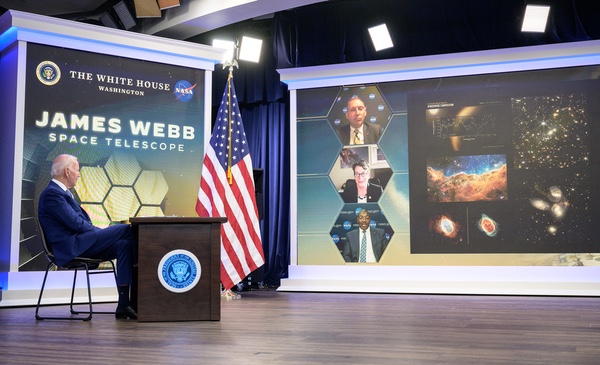 President Biden at a White House event July 11 to preview the first JWST images. (credit: NASA/Bill Ingalls) |
Political transformation
Up until the launch, JWST was known as much for its cost overruns and schedule delays as it was for its science potential. Itd launch was delayed by years and its budget increased by billions of dollars, wreaking havoc on other aspects of NASA’s science portfolio.
| “You know, as an international collaboration, this telescope embodies how America leads the world not by the example of our power, but the power of our example,” President Biden said. |
There is, though, nothing like success to erase bad memories. By the time the images were unveiled last week, there was little discussion of its development problems by NASA or members of Congress. For example, Sen. Chris Van Hollen (D-MD), one of several members of Maryland’s congressional delegation that attended the Goddard event, mentioned “bumps along the way” in comments there, but added that, “once the launch happened, everything had to go perfectly. And it did because of all of you.”
JWST has undergone a remarkable transformation with its successful launch and commissioning: once a symbol of poor management at the agency, it’s now become a symbol of what NASA, and by extension America and like-minded partners, can do.
“You know, as an international collaboration, this telescope embodies how America leads the world not by the example of our power, but the power of our example,” President Biden said at the White House event. “A partnership with others, it symbolizes the relentless spirit of American ingenuity. And it shows what we can achieve, what more we can discover, not just about distant places, but about our very own planet and climate.”
Nelson told reporters after the Goddard event that the president was enthusiastic about the success of JWST and the images released. “The president says to me last night, ‘Hey, Bill, do you need any money?’ I said, ‘Mr. President, I could use a little help with the Office of Management and Budget in your White House,’” he said.
Nelson suggested that the success of JWST could help it win support with both international partners as well as on Capitol Hill, where the agency is trying to secure $26 billion in fiscal year 2023. “I’m not worried about the Congress,” Nelson said, citing public support for the agency and programs that include JWST. “I think the Congress will respond with what we need.”
The House did not give everything NASA asked for in its budget, providing $25.4 billion instead of the requested $26 billion in a bill House appropriators approved last month. The Senate has yet to take up its version of a spending bill.
Van Hollen, who serves on the Senate appropriations subcommittee whose jurisdiction includes NASA, said the subcommittee was starting to draft its version of the bill while awaiting overall spending allocations. Regarding NASA’s budget proposal, “we’re going to be pushing very hard to make sure that we fully fund their budget request.”
The one controversy remaining about JWST is the name itself. Many astronomers object to having the telescope named after the Apollo-era NASA administrator because of allegations that he discriminated against LGBTQ employees at NASA and, earlier in his career, at the State Department. NASA, in response, commissioned in 2019 a historical review to look for evidence to substantiate those allegations.
“The NASA leadership took very seriously the investigation into whether or not the James Webb Space Telescope should be renamed,” Paul Hertz, director of NASA’s astrophysics division, said at an advisory committee meeting in March. “At the moment, based on the historical research available at this time, NASA has decided not to rename the James Webb Space Telescope.”
That historical research was incomplete, though, because many archives containing relevant records were closed during the pandemic. Those archives have now reopened, and Hertz said then that NASA’s historian, Brian Odom, was starting a review of the records there to look for additional evidence.
NASA had not provided updates on that review since then. When the controversy came up at last week’s briefing, a NASA public affairs officer moderating the panel stepped in to say that the agency would be providing an update on the historical review “soon.”
None of the panelists weighed in, but one, Rigby, later tweeted that, speaking as a private citizen, “a transformative telescope should have a name that stands for discovery and inclusion.”
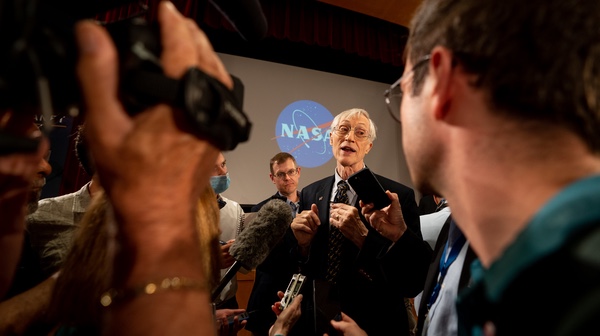 John Mather, who has been working on JWST since 1995, told reporters he was “so thrilled and so relieved” the telescope works. (credit: NASA/Taylor Mickal) |
Endings and beginnings
For some, the completion of JWST’s commissioning and the release of the first observations was the end of a decades-long effort. “As the commissioning winds down and we’re into science ops, we’re in a support role,” said Northrop Grumman’s Atkinson. “We’re there, ready to help whenever it's needed. Hopefully that call won’t come.”
| “How could you not discover stuff if you’re a hundred times more powerful than previous telescopes?” Rigby said. “Yeah, this is going to be revolutionary.” |
The company, he said, was gathering lessons learned from JWST it might apply to future programs. “We want to make sure we collectively pool the knowledge base of all the people who’ve been working on the program for a very long time to try to make sure we don’t lose any of those nuggets going forward.”
For astronomers, though, the mission is just getting started. While designed for a ten-year life, NASA confirmed last month that the accurate launch of the spacecraft by Europe’s Ariane 5 minimized the need for trajectory correction maneuver and left the spacecraft with enough stationkeeping propellant to operate for 20 years.
“It’s a cliché, but we’re turning the page on several new chapters on exoplanet atmospheres, the early universe,” Doyon said. “We don’t even know what we’re going to find.”
Rigby said that JWST promises to be two orders of magnitude—a factor of 100—more sensitive than other infrared telescopes. “How could you not discover stuff if you’re a hundred times more powerful than previous telescopes?” she said. “Yeah, this is going to be revolutionary.”
John Mather, the JWST project scientist at Goddard, has been involved with the mission since 1995, shortly after leading the COBE mission to study the cosmic microwave background that won him the Nobel Prize in physics. “I am so thrilled and so relieved,” he said at the Goddard event of the first JWST images.
“We are so thrilled that it works because there was so much at risk,” he said later. “The world has trusted us to put our billions into this and make it go, and it works. So it’s an immense relief.”
Note: we are using a new commenting system, which may require you to create a new account.
